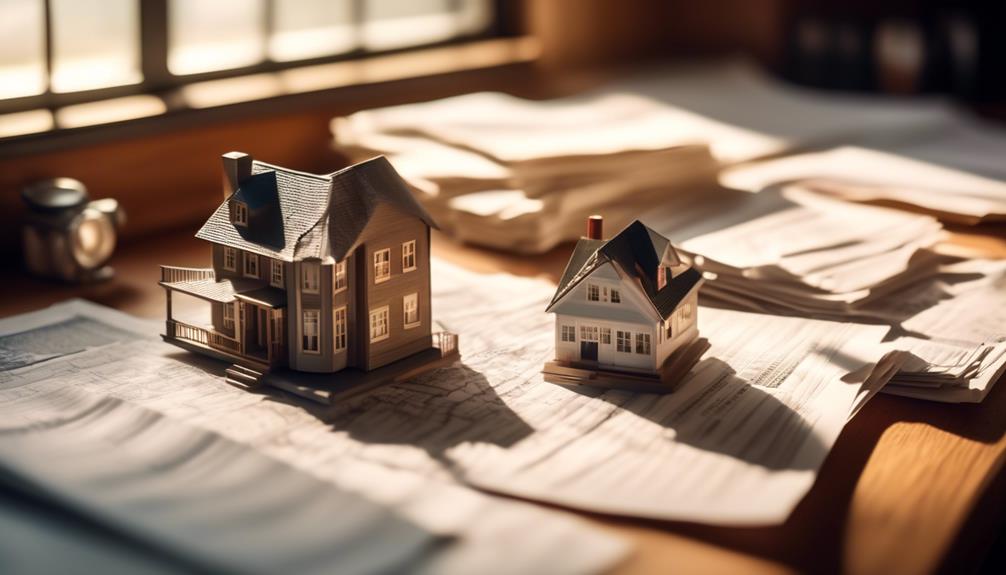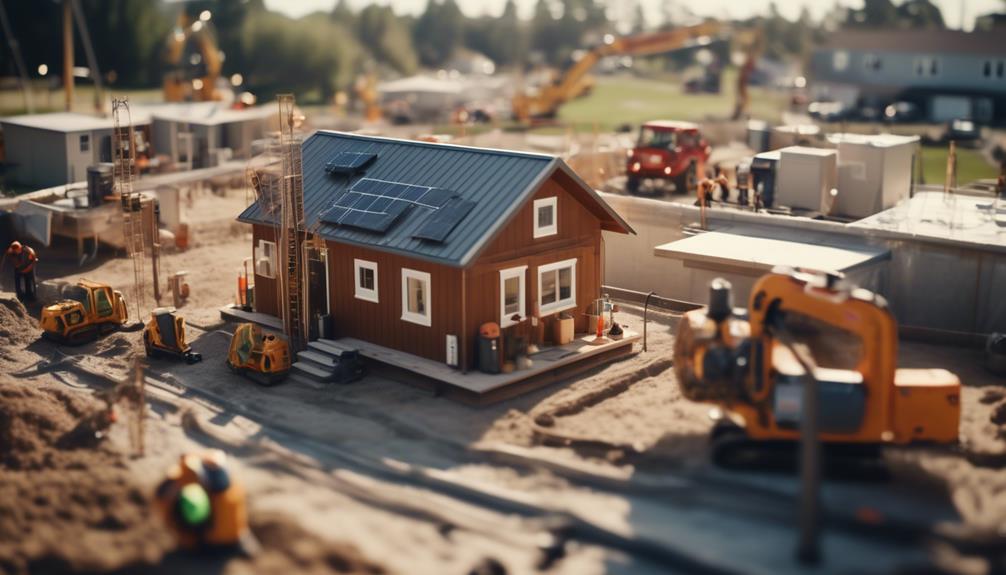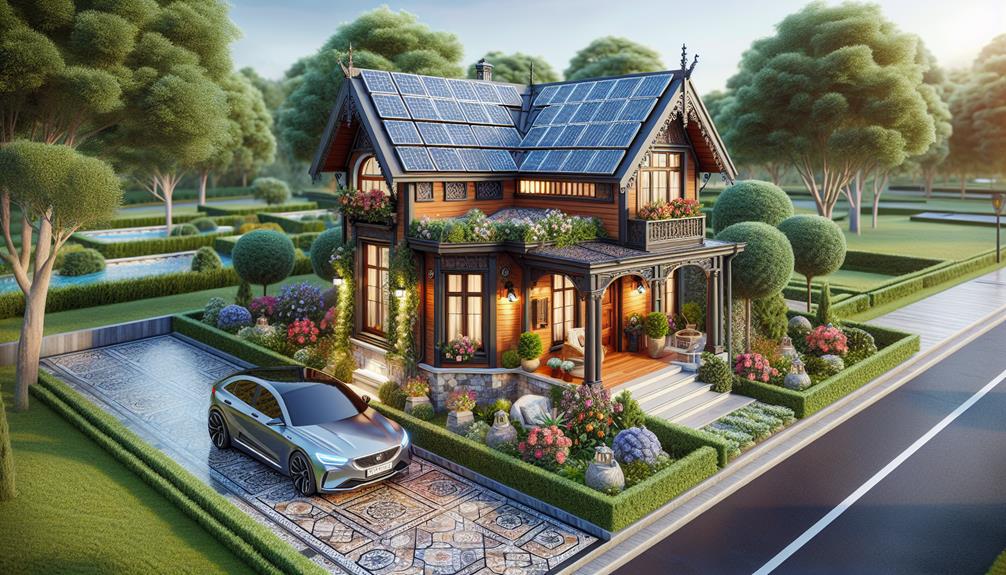You've probably heard that good things come in small packages, but when it comes to tiny homes, the price tag might surprise you.
As you contemplate downsizing to a more minimalist lifestyle, you may find that the costs associated with building or purchasing a tiny house are not as diminutive as the square footage. High-quality materials, custom design elements, and the intricacies of land acquisition can inflate the overall expense, challenging the notion that tiny means cheaper.
Furthermore, navigating zoning laws and connecting to utilities often present hidden costs that are easily overlooked in the initial budget.
As you weigh the dream of living big in a smaller space, let's explore the financial realities that might make you pause and reconsider the true cost of going tiny.
Key Takeaways
- High-quality materials and custom designs contribute to the high costs of tiny homes.
- Utility-related expenses, such as compliance with zoning challenges and utility connection expenditures, add to the overall cost.
- Limited economies of scale in small-scale production result in higher per-unit costs and limited bargaining power.
- Additional expenses such as utilities, rent, shipping costs, skilled labor, and regulatory framework costs further increase the cost of tiny homes.
High-Quality Material Costs
The use of premium materials significantly elevates the construction costs of tiny homes. Every high-grade lumber piece, appliance, and fixture adds to your financial outlay. In the pursuit of innovation, the cost of building with such materials often reflects their enhanced durability and aesthetic appeal. However, this investment can be daunting, with high-quality material costs driving up expenses considerably.
During the building process, you'll find that certified materials and state-of-the-art appliances come with a premium. This premium is not only in upfront costs but also in the skilled labor required for their installation. Moreover, the expense per square foot is typically higher for tiny homes due to the precision and efficiency demanded by the smaller scale.
These factors combined ensure that your tiny home will be built to last but underscore the significant financial commitment required.
Custom Design Expenses
You'll find that specialized architectural planning is a significant factor in elevating the cost of your tiny home. Hiring professionals to draft a unique layout that optimizes your limited space doesn't come cheap.
Opting for unique materials not only affects aesthetics but also impacts your budget due to their rarity and higher market value.
Moreover, tailored furniture solutions that maximize functionality in a compact living area require custom work, which adds a premium to your overall expenses.
Specialized Architectural Planning
Hiring architects and designers to craft personalized blueprints for a tiny home significantly drives up the project's cost due to the meticulous attention required for each unique aspect of its design. This specialized architectural planning isn't merely a luxury but a necessity for those who seek to optimize the limited space tiny homes offer.
Every square inch must be accounted for, and common prefabricated designs often don't cut it for innovative clients. The customization process involves not just aesthetics but also the integration of multifunctional features and sustainable materials, which can be more expensive.
With the high price of building a home that breaks the mold, specialized planning ensures that your tiny home isn't just a dwelling, but a tailored, efficient, and innovative living space.
Unique Material Costs
When opting for custom-designed tiny homes, you're likely to encounter higher costs due to the unique materials and labor required for their construction and maintenance.
The tiny house movement often celebrates individuality, which translates into custom preferences for design and materials. These unique material costs can significantly impact the median cost of your tiny home. Whether it's specialty-sized lumber, advanced insulation materials, or bespoke windows, every tailored feature comes with a price point that exceeds standard options.
Moreover, navigating local zoning laws can introduce unexpected expenses, as can the installation of off-grid utilities like solar panels or septic systems. These innovations are crucial for sustainability, but they add layers of cost to your tiny home's final bill.
Tailored Furniture Solutions
Customizing furniture for your tiny home often entails higher costs, as it requires expert craftsmanship to maximize the utility of every square inch while ensuring your personal style is reflected in each piece. When you're investing in tailored furniture solutions for your compact living space, you're not just paying for a piece of furniture; you're investing in a multifunctional and aesthetic element that must fit seamlessly into your home.
- Skilled Labor: Custom pieces demand precision workmanship, driving up labor costs.
- Unique Designs: Bespoke designs are pricier than off-the-shelf options due to their one-of-a-kind nature.
- Custom Measurements: Tailoring to exact dimensions necessitates additional time and resources.
- Personalized Solutions: Creating unique furniture that suits your taste and space adds to the expense.
These factors contribute to the elevated expenses associated with innovative tiny home furniture solutions.
Land Acquisition Challenges
Navigating the complex landscape of zoning laws presents a significant hurdle for prospective tiny home owners seeking suitable plots of land. As you delve into the real estate market, you'll find that the limited availability of land in desirable areas can significantly inflate the Cost of Living. High-demand locales often come with a hefty price tag, making the dream of owning a tiny home less attainable.
Here's an analytical breakdown of land acquisition challenges:
| Factor | Impact on Tiny Homes |
|---|---|
| Zoning Restrictions | Limits suitable locations |
| Desirability | Drives up land prices |
| High-demand Areas | Increases acquisition costs |
| Regulations | Adds expenses for permits |
These challenges underscore the intricate balance between the tiny home lifestyle and the realities of real estate economics.
Zoning and Regulation Fees

As you navigate the financial landscape of tiny home ownership, you'll find that zoning and regulation fees can be a stealthy adversary, inflating your budget with permitting process costs that often go overlooked.
Land use restrictions may hem you in, demanding a precision in compliance that translates to more out-of-pocket expenses.
Moreover, aligning your tiny home with utility compliance expenses isn't just a matter of convenience but a legal imperative, potentially adding thousands to your final tally.
Permitting Process Costs
While zoning regulations are intended to ensure community standards, they often introduce a layer of expensive bureaucracy for tiny home owners, significantly inflating the overall cost of establishing a diminutive dwelling. You're not just buying a few hundred square feet of living space; you're navigating a market thick with regulatory tape.
Consider these key factors that drive up permitting process costs:
- Varying Local Zoning Laws: Costs fluctuate dramatically based on location, complicating budget predictions.
- Utility Hookup Fees: Off-grid setups can demand pricey investments in infrastructure.
- Eco-friendly Additions: Rainwater systems and solar panels, while sustainable, tack on upfront expenses.
- Custom Materials: Tailored sizing often means higher prices for both materials and labor.
Navigating this landscape requires a keen analytical approach to balance innovation with regulation-induced expenditures.
Land Use Restrictions
Beyond the complexity of the permitting process, land use restrictions further complicate the financial landscape for those investing in tiny homes, with zoning and regulation fees often imposing a significant cost burden.
As you navigate this terrain, understand that zoning regulations can vary wildly, which means you're facing a patchwork of local laws. The compliance with building codes specific to Tiny Houses isn't just a checkbox; it's a financial hurdle. These regulations dictate additional expenses, from utilities to rent, and even the cost of shipping your home to its designated plot.
Moreover, the skilled labor necessary to ensure your home meets these stringent standards doesn't come cheap. As a house owner of a tiny home, you're not just buying a space—you're buying into a regulatory framework that can significantly inflate the overall cost.
Utility Compliance Expenses
Navigating the labyrinth of utility compliance expenses, you'll discover that zoning and regulation fees are often a hidden yet substantial cost in owning a tiny home. The housing market has warmed up to the idea of tiny homes, but the regulatory framework can still be a cold shower for your budget.
- Zoning Challenges: Local regulations may not have caught up with the tiny house kit revolution, imposing traditional standards that don't fit.
- Building Codes: Compliance with building codes designed for standard homes can inflate the price tag.
- Utility Hookups: Integrating electricity, water, and sewage in a condensed space can be complex, leading to higher costs.
- Regulation Fees: Each compliance certificate and permit comes with a fee, adding layers to the financial commitment.
You're investing in innovation, but these utility compliance expenses can dampen the allure of a simplified lifestyle.
Utility Connection Expenditures

Utility connection expenses for tiny homes can quickly escalate, particularly when integrating systems like solar power or septic tanks in remote, off-grid locations. You're not just buying into a smaller square footage; you're investing in a lifestyle that, while innovative, can come with hefty upfront costs. Your tiny home might appreciate in value, but the initial outlay for utility connection expenditures can be a tough pill to swallow.
| Utility Type | Cost Factor | Consideration |
|---|---|---|
| Solar Power | High | Long-term savings potential |
| Septic System | Variable | Depends on local regulations |
| Water | Moderate | Rainwater collection systems |
| Electricity | High | Off-grid complexities |
| Gas | Moderate | Proximity to supply lines |
Each line item in your budget must be scrutinized. Understanding the full scope of integration challenges helps ensure your tiny home remains both a sustainable and financially viable venture.
Limited Economies of Scale
While considering the hefty utility connection costs for your tiny home, it's also crucial to recognize that the lack of economies of scale further inflates your expenses. Unlike traditional houses of average size, tiny homes don't benefit as much from the cost efficiencies that come with bulk production and purchasing.
- Small-scale production: The unique, often custom nature of tiny homes means they can't capitalize on the price reductions of mass manufacturing.
- Higher per-unit costs: Due to limited production runs, each tiny home incurs a higher cost for materials and labor.
- Limited bargaining power: With fewer units, tiny home builders lack the negotiating clout to lower prices.
- Inefficiencies in construction: Smaller builds don't always translate to streamlined processes, potentially leading to unnecessary cost increases.
Frequently Asked Questions
What Is the Most Expensive Part of a Tiny House?
The most expensive part of your tiny house often involves custom design, with space-saving furniture, high-end appliances, and zoning challenges also contributing to steep costs in your quest for compact, innovative living.
Why Does It Cost More to Build a Small House?
Navigating the scale paradox, you'll find building small isn't just about shrinking dimensions. It demands custom design finesse, space optimization mastery, and material efficiency, all while threading the needle of innovative, cost-effective construction.
Are Tiny Homes Worth the Money?
From an investment perspective, you'll find tiny homes' resale values risky. They're a lifestyle fit if you embrace downsizing challenges, yet may not align with innovation-seekers' expectations for financial return.
What Are the Problems With Tiny Homes?
Ironically, you'd think tiny homes simplify life, yet zoning challenges, the quest for a minimalist lifestyle, and downsizing difficulty often complicate space optimization, contradicting the ease that tiny home living promises to deliver.
Conclusion
In the end, you're navigating a financial labyrinth when investing in a tiny home.
The high-quality materials, tailormade designs, and elusive land are like pricey threads in a complex tapestry. Every stitch from zoning hurdles to utility hookups weaves into the cost, while economies of scale remain a distant dream.
It's a pocket-sized paradox where less physical space doesn't always mean less financial space. So, tread carefully; the tiny home market is deeper than it looks.

